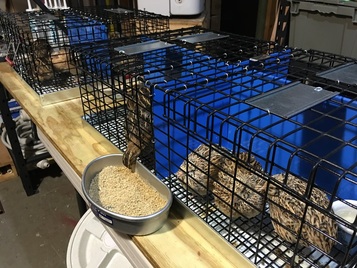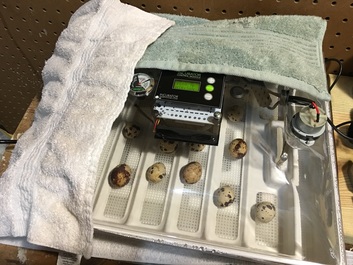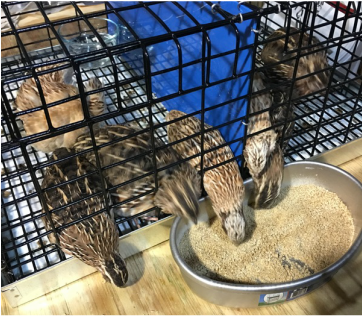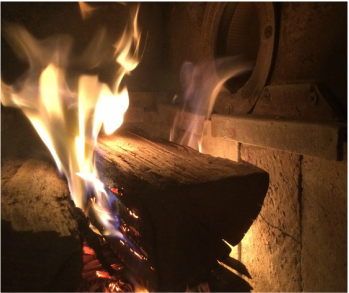 When we first brought the quail home we had not yet decided on how we were going to permanently house them. The logical choice seemed to be the three divided rabbit carriers that were not being used. Two of the cages have two chambers each and one has four. The space was small, but it allowed for separation of quail by color and gender. While they did fill the need, they were not the most ideal living arrangement for the quail. Cramped quarters lead to fussy birds and we can now say that we understand the origin of the word “henpecking”. Another disadvantage of using the rabbit carriers is that there is not much room between the floor of the cage and the removable tray underneath. This makes for little room for the bird poop to drop away from the birds. We discovered that the odors were greatly reduced with the installation of a liner. Puppy pads did the trick as long as they were changed frequently. We were excited to finally receive permanent housing for the quail because it meant that cleaning would be easier, the birds would have more room, and the eggs could roll out of the living area for a simpler and cleaner collection.  The birds’ time in their temporary housing was not without accident. One of the larger hens experienced a rather unusual injury when she broke off a large portion of her upper beak. There was a significant amount of blood loss which stopped before I had time to get a coagulant. It did, however, leave quite a mess all over the cage. She was quickly isolated to keep the other birds from pecking at her. We were also concerned that she may have problems eating and drinking since there was such a large difference in length between the upper and lower parts of her beak. Fingernail clippers were used to shorten the lower beak slightly. We are happy to report that she has made it through the ordeal and is now living a normal and productive life.
1 Comment
 Our first incubator/hatcher was a fully automated desktop unit from Incubator Warehouse. We bought the one made of high density plastic over the other Styrofoam models because it would be easier to clean and disinfect properly after the hatch. Out of convenience, we set the incubator up in the basement where the temperature hovers at a constant 66ºF. The cooler atmosphere made it difficult for this small incubator to maintain the 99.5ºF temperature required for incubation. We wrapped the unit in towels to help keep the heating element from operating at 100% capacity. We were pleased with the hatch rate for our first batch, but have not been very pleased with the smaller unit’s performance for several reasons. One of the difficulties we noticed is that it takes a significant amount of time to return to temperature after the unit was opened for candling or adding water, even with towels in place to trap in heat. Another problem is that the humidity gauge is relatively worthless. It never read accurately and there is no good place to set a wet bulb thermometer so that it remains wet. According to the gauge, we never achieved the proper lockdown humidity level despite placing wetted sponges directly under the fan. Additionally, all of the eggs rested on their sides for the duration of the incubation and hatch. This may be a minor issue, but due to the disparity between the quail egg size, the large turning tray channel widths, and the short throw of the turning motor, I have serious questions about how well the eggs are actually being turned during incubation. Because of these concerns, and our desire to set multiple batches concurrently, we have since moved to a cabinet incubator and separate cabinet hatcher. They were expensive, but they address all of our concerns with the smaller incubator/hatcher while also automatically regulating humidity.  Our original plan was to begin the year by introducing rabbits onto the farmstead. We chose to use stackable cages because of the limited area in the barn, which is the best area for us to house the rabbits. Equipment was ordered from a reputable manufacturer with one of the best stackable rabbit cage designs. Unfortunately, the manufacturer, due to a series of nearly comical circumstances, is now five months behind in fulfillment of orders and apparently nobody is cancelling. To prevent our plan for this year from becoming seriously derailed, we have moved forward with the introduction of Coturnix quail to the farmstead. Our first batch of quail came from a nearby family that had them listed for sale on Craigslist. We bought 28 birds and soon discovered that the cock to hen ratio was much too high. Because males eat the feed but obviously do not produce eggs in return, eight of them quickly found their way to the dinner table. Let’s just say that the first meal was not the best. Cooking quail is similar to cooking chicken, but not exactly the same. We will need to experiment with different recipes and techniques to get it perfected.  Here is Anastasia holding our first egg. What an expensive egg that was! It took nearly two weeks for the hens to become relaxed enough in their new home to begin laying again. We were worried for the entire waiting period that we had bought birds that were just too old to lay. After sexing the birds and separating the cocks from each other, we paired them up with hens and began collecting fertile eggs. We were excited to amass our first batch for incubation, which will be discussed further in the next blog post.  Without going too far off the deep end, we see an ever-pressing need to be able to economically provide as much untainted, untreated food for our family as possible. We will reduce our dependency on the public food supply while reducing the myriad of pesticides, preservatives, and growth chemicals that we consume through our food. Simultaneously we will decrease our food bill while drawing us closer to God and His creation, and also creating a sense of security should something catastrophic happen in the future. Beyond meeting our own needs, we intend to sell select items to the public and also donate a portion to church functions and local homeless shelters. Each of us has at least one chronic medical condition that benefits from a reduction in processed foods and an increase in quality whole foods. Our family lives with a wide range of ailments including seasonal and food allergies, asthma, cold urticaria, eczema, high cholesterol, fibromyalgia, endometriosis, and even the loss of a gall bladder. Naturally grown and raised food sources help us reduce the impact these medical issues have on our lives. Providing for our own needs is an integral part of that, as we transition from a mostly mass-produced diet to one where we control the content of what we consume. It will not cure all of our ills, but the difference is noticeable and the satisfaction is incalculable. We value logical planning, hard work, determination, smart budgeting, open communication, honesty, fairness, family time, humor, humility, and faith. We strive to be better at each of these things every day. We aim for synergy within the family structure and, realizing that this is sometimes impossible, we also work to remain flexible. We love to spend time with extended family but, unfortunately, we do not live very close to any of our relatives. Hopefully, one day we will be able to realize a longstanding dream of living closer to our families. Until that day, we will make the most of what we have, where we are.  Our property is rather odd in that it is triangle shaped and has an average downward slope of 12 degrees from front to back. There currently are no earthworks to control water runoff, and there is a storm drain in the street at the front right corner of the property that dumps precipitation out near the swimming pool. We are on the North side of a hill, which receives more shade and further complicates our ability to grow some of the crops and trees that we desire. The red area is a permanent easement of the Columbia Gas Pipeline, on which we are not allowed to build any permanent structure. The picture to the right is of a 3D model that I created to depict how we want to utilize our property. It is beneficial to helping us plan the order in which changes must be made so that no effort is wasted, duplicated, or done prematurely. The area behind the barn, located at the center of the property, is yet to be developed. Our plan is to divide the area up into equal sections, or paddocks. A paddock system will effectively increase the property size as rotational grazing allows unused sections to recover more quickly. The areas with ponds are currently forested and the areas behind them were clear-cut and graded by the pipeline as a temporary easement. The goal is to be able to manage chickens, ducks, geese, turkeys, peafowl, and goats on the property in a paddock system and utilize the barn for raising quail and rabbits. We will do everything we can to minimize feed costs and waste, such as planting an orchard, planting edible forage within the paddocks, growing some of our own crops more abundantly as supplemental intake for the animals, sprouting grains as fodder, and composting. We also plan to keep bees on the property to provide a natural source of sweetener and to help with pollinating. The ultimate goal is to create an ecosystem where the individual parts work together in symbiosis for our benefit; basically, to make a thriving micro-farm.  In the past, Geoff and I have worked demanding jobs with long hours and high stress which only left us with conflicting priorities, poor communication, and always a desire for more time, more money, and more things. Our focus has shifted. We now desire to draw closer to God by being more connected to His creation. God’s plan is first revealed in the Garden of Eden when He picked up the dirt and breathed life into it creating Adam. We do not have God’s power, but we can tend the land with the same care and compassion. The soil can be maintained to bring life to fruits and vegetables and, in doing so, provide sustenance for our family and our animals. Geoff and I often joke that my extra rib was originally part of his body. However, we both know that is not actually how I came to have one more rib than him. But, like Adam and Eve, we were created to work together: Geoff, as the leader and me, as his helper. God gave Adam dominion over the animals and after the fall he added the arduous task of working the land. Geoff is the mastermind of this new life. The planning, the preparation and, to be perfectly honest, most of the actual labor will be his doing. Of course, he will have Anastasia around to help him during the day. After the fall, God punished Eve with painful childbirth. I have done that once and, thankfully for me; we are now past that point in our lives. God also gave Eve the responsibility of being her husband’s helper. My responsibility is to help him achieve the desired outcome through financial backing and to occasionally assist him around the farmstead. I am to be his cheerleader and his strongest supporter. We have almost 3.5 acres of beautiful Pennsylvanian land. To do nothing would be a pure waste of what has been provided to us. We are jumping off the hamster wheel and returning to a more agrarian lifestyle. We are a family focused on God’s plan for our lives while working together to care for the blessings that He has provided. |
AuthorThis is a family affair. We all get involved in documenting our life in the woods. Archives
April 2017
Categories |
 RSS Feed
RSS Feed